Looking out over the beautiful scenery below, swaying bamboo, azaleas and landscaped lakes, I couldn’t help congratulating Mao Zedong on his choice of a hideout: what could be better than an abundance of fresh water, healthy crops and great scenery on top? I find it difficult to believe that this was once a remote impoverished area, ripe for revolutionary mobilization. Jingganshan is where Mao and his faithful right-hand man Zhu De built up the Red Army almost from scratch, after a number of failed uprisings in nearby Nanchang and Changsha in1927.
A Brief History

Mao used his stay in Jinggangshan to put into practice his ideas on rural revolution; testing what type of peasants would support revolution – generally the poorest ones – and which peasants would oppose it. Quite often, the analysis simply came down to whether the peasant owned a pig or not. Any pig-owning peasant could be considered rich, and therefore reactionary. Besides theorizing, Mao relentlessly worked on consolidating his position in power, ruthlessly exterminating any opposition, which resulted in the deaths of thousands of loyal members of the Chinese Communist Party (CCP).
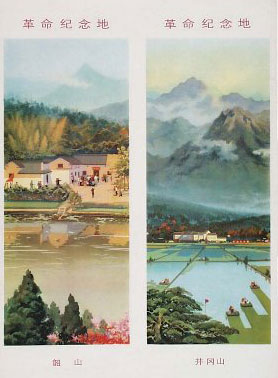
Still, Mao found his fortunes in Jinggangshan rise and fall several times. He was successful in repelling efforts by Chiang Kai Shek’s Nationalist Army to take Jinggangshan by using guerrilla tactics to make up for the double drawback of the Red Army’s inferior numbers and the Nationalists’ modern weaponry. However, he found his position in the CCP continually challenged, especially when the party leadership was forced out of the cities and moved into Jinggangshan. They often criticised Mao over his military tactics, and eventually they won the day. Mao was sidelined and the CCP leadership, under the instruction of Russian advisors, decided to abandon the guerrilla strategy and engage the Nationalist forces head on. The consequences were disastrous and resulted in a series of heavy reversals for the Communists. Eventually, finding themselves completely surrounded, the Communist forces broke out of their Jinggangshan stronghold and embarked upon what became known as the Long March.
Jinggangshan Today

Today, Jinggangshan is a must- see tourist hotspot for millions of Chinese. However, the reasons for visiting have radically changed over the years. Long gone are the days when millions of Red Guards would descend upon the town to pay homage to the Great Helmsman. These days, tourists come to enjoy the spectacular scenery, walk along beautifully maintained nature trails, admire the stunning azaleas, gorge themselves on rare forest animals, and why not, drop in on the odd reminder of the CCP’s glorious past.
For the independent traveller, Jinggangshan presents a great opportunity to get out into some fantastic nature; though it will take a bit of organising. Hiking trails, which usually end up at a beautiful waterfall or a stunning view point, are endless; though most of them require an entrance ticket.
Speaking of which, the number one rule when visiting the Jinggangshan area is to buy a multi-entrance ticket in Ciping Town (100 Yuan), or you’ll end up paying a fortune, as most individual sites charge around 30 Yuan.
Getting information and organising visits is a little bit confusing, even if you speak Chinese. Public transport is limited and tours are expensive. The best option is to get together with other individual (Chinese) travellers and hire a vehicle for the day, arranging pick up times from the places you want to visit.
Things to see
We spent one day in and around Ciping Town, visiting the various historical sites related to the Revolution and the Red Army; a ´must’ for a History buff such as myself (I graduated in Modern Chinese History). We popped into the Museum of the Revolution, as well as the houses where Mao and other legendary CCP leaders once were based Later on, we hired a vehicle that took us to Huangyangjie 黄洋界, the stunning and famous view point that overlooks the battle grounds where Mao’s guerrilla army would ambush the approaching Nationalist troops.
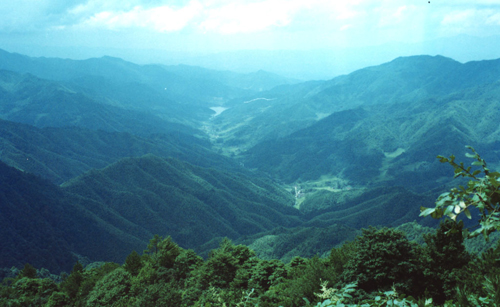
Finally, we climbed up to the Martyrs’ Monument overlooking Ciping. It is quite possibly the ugliest monument we’ve ever seen. It’s a yellow abstract thing on an already stained brown pedestal. However, the views over the famous Five Finger Peaks of Jingganshan compensate for the efforts of climbing.
On day two, we visited the Longtan, or Dragon, Pools Scenic Area, which also boasts a Red Amy Cave Hospital. The cave is, well, just a cave, but the scenic area is spectacular. The long, semi-circular route is the best, as it avoids the crowds who mostly take the shorter way and cheat by getting on the cable car (see our hand-drawn maps).
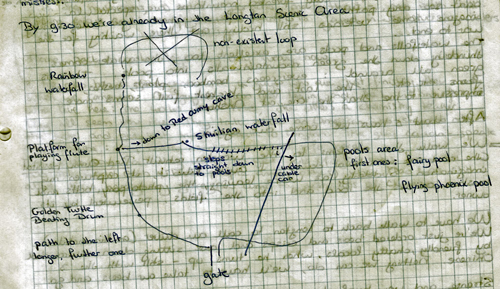
From the entrance gate, you should follow the longer, higher path, which will take you to the Rainbow waterfall in about an hour and a half. Looking at the official site map, it seems as if you could go beyond the Rainbow Falls and continue the loop. However, in reality, the path ends at the Falls, and you have to backtrack to the ‘Platform for Playing Flute’, from where you can complete a shorter circuit.
The trail is well- marked and the scenery breathtaking. Beware that the descent into the valley from ‘Platform for Playing Flute’ is pretty treacherous. It gets so slippery that I went head over heels more than once. There are signs that warn you about this, if you can make sense of the English (see sign)…
The first stop after the Platform is the Cave, followed by the Shuilian waterfall and a whole series of gorgeous waterfalls and pools. At the first of these, local people sell cold drinks and snacks. Sitting there, watching the water come thundering down, with colourful dragonflies buzzing around you, is a great way to finish the walk.
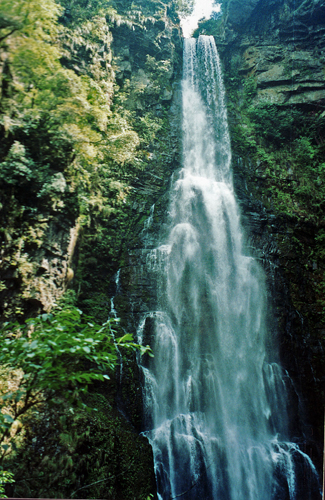
About half a kilometre outside the Scenic Area there is a replica of a wooden Red Army Hospital; the real one was burned down. It is quite an atmospheric place, worth a quick stop.
In the late afternoon our driver picked us up, and took us to Shui Kou 水口, another scenic area, stopping at a couple of very mildly interesting tourist sights along the way. One of them was an alcohol distillery, specialising in snake and salamander wine. There are rooms with armchairs where you can sample the stuff, as well as the opportunity to see some of the live specimens. We declined. The other sight was a replica of a house Mao had once used as a base, which was burned down by local ‘reactionaries’. Maybe he wasn’t so popular after all.
The Shui Kou scenic area, however, is another great example of the extraordinary scenery of Jinggangshan. This is where you will see the famous square-stemmed Bamboo and the various types of Azaleas, which unfortunately weren’t in bloom when we visited in early September. Apparently they flower in May. Azaleas or no Azaleas, the superbly maintained trails that lead you alongside babbling steams, past tempting pools and cascading waterfalls, onto a whole range of tempting view points make this place worth a visit. You could easily spend a few days, just exploring this place.
Practicalities
Accommodation:
The first night, due to our late arrival at 3.00 am, we stayed in a nameless and vile hotel. The next day, we checked into the excellent, good- value Shangmao Hotel (商贸宾馆), which charged 150 Yuan for big, bright and airy rooms. The hotel is on the hill on Ciping’s main street. The staff were really friendly. There is no shortage of hotels in Ciping, but we found many of them either too expensive, full, or unwilling to take foreigners. However, it is more than likely that the hotel situation will have changed by now.
Food:
There are plenty of restaurant signs offering delicacies from the forest 山珍海味 ( basically rare and endangered forest animals). However, you can easily avoid such temptations, as many of the small restaurants make delicious dishes from local vegetables, especially mushrooms and boletus. Another speciality was a type of huge river scallop扇贝, found in the local rivers, delicious when fried with garlic, chilli and ginger and served in the shell.。
Getting Around:
A bit tricky. Many Chinese tourists come on organised tours, and public transport to the tourist sites is few and far between, and in many cases non-existent. At the time of our visit, there weren’t any other foreigner travellers to hook up with either.
We ended up finding a mini-van driver who covers various routes around Jinggangshan (announced on his van) and sharing him with a small group of Chinese tourists. We actually went to different places than they did, but arranged beforehand with the driver where and when to pick us up. We paid 60 Yuan each. Here is his mobile number: 13970460021 (for what it’s worth). He doesn’t speak English, but he knows what you want to see.
Coming and Going:
We arrived in Jinggangshan by bus from Changsha. It was one of those nightmarish journeys that you will never forget, and can entertain your friends with years later. It took close to 15 hours, along some of the worst roads and on one of the worst buses we have ever been on. I am sure that conditions have improved since then and I have heard that the journey now takes a mere 9 hours. Buses leave from Changsha’s Southern Bus station. For a full account of the journey see From Our Diary.
Approaching Jinggangshan from Jiangxi’s capital city Nanchang is far more convenient. Plenty of buses go every day in either direction. It took us about 6 hours to get to Nanchang, but new motorways seem to have reduced that by a few hours.


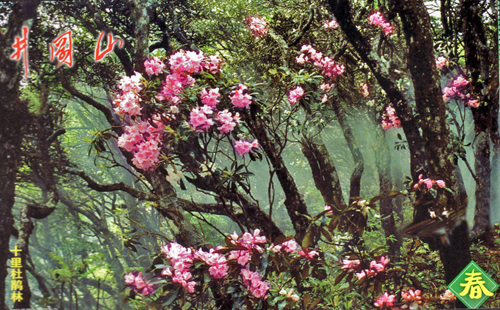
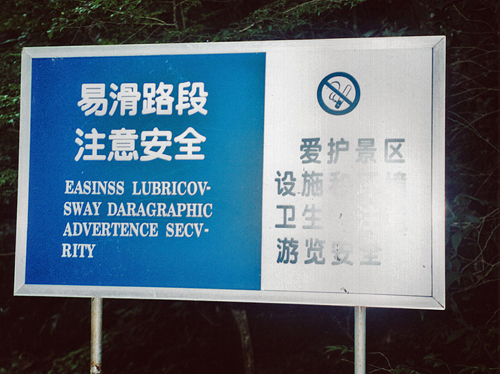
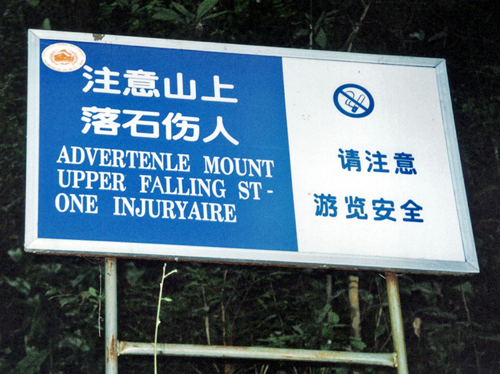
OMG your post is so good and show many things true about Jinggangshan in the past. As a local here, it’s really interesting to see how other people, especially foreign visitors feel about the mountain in such early year, 2009! I was just about 5 years old that time. I’m happy to find that you enjoyed some parts of the journey and also learned how my home town tourism situation was in the early 2000. You visited so many places that I even never go to, lol. To be honest, the tourism here in the past did have something making people confused or uncomfortable, but in resent years, things have become much better, such as transportation( a train station built and a high-speed rail station on coming), accomodation( 150 yuan a night in hotel was actually rather expensive in more than 10 years ago), tour guid service and travel experience improvement. Hope the beautiful scenery here can always be a part of your good memory.
Thank you
I studied Chinese modern history, so a visited to Jingangshan was obligatory. Some of the scenery was the best i have seen in China.
And even though transport was not smooth, it was excting and I have never forgotten the ride from Changsha. I hope to have the opportunity to return again one day.
Adam